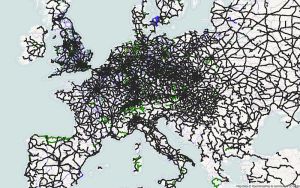The modernisation, integration and expansion of rail networks in the European Union is opening exciting new possibilities for Europe’s global navigation satellite systems (E-GNSS), Galileo and EGNOS. Already used to offer non-safety services such as asset management and passenger information, an augmented GNSS linked to a range of sensors could provide signalling and train control services that meet stringent European safety standards.

Map of railways in southern and central parts of Europe. Main operational lines in black, heritage lines in green and former routes in light blue.
With the development of the European Rail Traffic Management System (ERTMS), which aims to harmonise the different systems used by European rail providers within a single set of standards and certification requirements, there is considerable potential for synergy between rail operators and Europe’s GNSS. To move this agenda forward, the French Ministry for the Environment, Sustainable Development and Energy (MEDDE), jointly with the French National Space Research Centre (CNES), held a one-day seminar in Lille (France) on November 20. Around 100 participants from the fields of industry, research and government attended the meeting to discuss their needs and potential contributions.
“The workshop is an unprecedented initiative, aiming to create a dialogue between rail stakeholders and satellite navigation experts,” says MEDDE Galileo Coordinator David Comby. “Only by working across expertise and sectors can we respond to the needs for increased safety, efficiency and sustainability in the rail sector.”
Benefits for Europe’s low-density lines
Precise, real-time localisation of trains is critical for the prevention of accidents, as well as for the safe and reliable operation of rail networks. According to the present version of the ERTMS specifications foreseen for implementation, this requires the deployment of balises (electronic beacons) that are costly to buy, install and maintain. Additionally, the balises are often not cost effective for signalling and train control on low-density lines.
GNSS offers obvious potential for these low-density lines, where satellite position information can lower the cost of signalling by reducing the number of line-side components required, while also improving safety. Even for mainline applications, GNSS can reduce the number of physical balises and improve the precision of odometry.
Time for adoption by rail
GNSS is already extensively used in aviation, marine and vehicle navigation, but the peculiarities of rail transport have prevented its deployment for safety-critical applications, notably because of the unavailability of satellite signals when a train enters a tunnel, passes through a cutting or densely built-up area, for example. However, by integrating GNSS data with signals from other sensors, such as train-mounted eddy-current sensors and odometers, EGNOS can offer the integrity and increased positioning accuracy needed for next-generation signalling, train control and traffic management.
Two ongoing European R&D projects (GaLoROI and SATLOC) are already developing the necessary links between Galileo and these kinds of sensor for rail signalling on low density lines, which represent over 40% of the European network, and much more world-wide.
“The GSA’s mission is to support European Union objectives and achieve the highest return on European GNSS investment, in terms of benefits to users and economic growth and competitiveness,” says GSA Head of Market Development Gian Gherardo Calini. “We believe that E-GNSS can do a lot for the rail market segment, in terms of improved safety, efficiency and long-term sustainability.”

Galileo has been able to help society in so many ways. Like this post pointed out, it’s helping to increase the safety and lower the costs of European rail networks. With more research and funding, it’ll be interesting to see what other benefits Galileo will give society. Thanks for sharing!